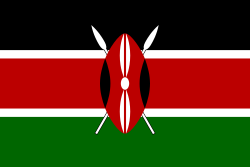Gabraa | |
|---|---|
 Gurreh dancers of the Gabra tribe | |
| Total population | |
| c. 700,000 | |
| Regions with significant populations | |
| 520,010 (2007) [1] | |
| 141,200 (2019) [2] | |
| Languages | |
| Oromo | |
| Religion | |
| Islam | |
| Related ethnic groups | |
| |
| Part of a series on the |
| Culture of Kenya |
|---|
 |
| Cuisine |
The Gabra Origins and Ethnolinguistic Affiliations
The origins of the Gabra people are complex and subject to ongoing debate, particularly concerning their historical relationships with other Cushitic-speaking groups in the Horn of Africa—most notably the Rendille, Somali, and Oromo (especially the Borana).
Contents
Cultural and Historical Linkages Several scholars and oral traditions suggest that there are strong cultural and ceremonial similarities between the Gabra, Garre, and Rendille. Both groups practice nomadic pastoralism, though the Gabra are primarily camel herders, whereas the Borana are traditionally associated with cattle rearing and farming. This shared pastoral lifestyle, particularly with the Rendille, has had a significant influence on aspects of Gabra identity and material culture.
One prominent theory posits that the Gabra may have descended from Somali-speaking ancestors and were originally Muslim, before their incorporation into the Oromo-speaking world. Supporting this view are linguistic patterns and elements of traditional prayer that reference Islamic holy sites, such as Mecca and Medina, along with the use of culturally Islamic names, which indicate their initial Islamic origin before the influence of other cultures. Some anthropological hypotheses propose that the Gabra are a historical offshoot of a Proto-Rendille-Somali group that gradually assimilated into the Oromo language and political structure, while preserving much of their earlier cultural framework.
A notable feature of Gabra identity is the belief in shared blood with the Somali, a concept that has historically influenced interethnic perceptions and even conflict avoidance, rooted in notions of kinship.
Distinction from Borana Despite linguistic and political alignment with the Oromo, the Gabra often define themselves as culturally distinct from the Borana. This distinction is reflected in differences in settlement and housing practices: the Gabra use mat-covered mobile tents, while the Borana traditionally build grass-thatched huts. Additionally, the two groups have experienced episodes of inter-group conflict, often driven by competition over grazing lands, water sources, and broader political tensions.
Linguistic Affiliation The Gabra speak a dialect of Boran, which belongs to the broader Oromo language group, a member of the Lowland East Cushitic branch of the Afroasiatic language family. This linguistic affiliation is one of the key factors linking the Gabra to the Oromo ethnic confederation, despite the cultural and historical arguments suggesting a dual heritage or syncretic origin. (Oromo : Gabraa),
They mainly inhabit the Moyale and Marsabit regions of northern Kenya and the highlands of southern Ethiopia. They mostly practice Islam and Christianity as religion, but maintain mandatory cultural practices.[ clarification needed ]. [3] [4] [5] [6] [7] [8]

